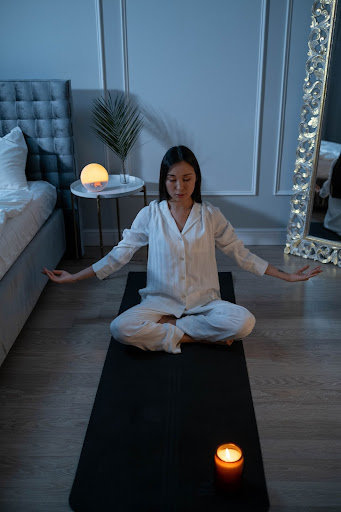
Feeling the struggle of the winter woes and wondering if it’s just you? Chances are, it’s probably not! Even in sunny southern California, the daylight hours dip this time of year and it can leave us all feeling a little bit meh.
Seasonal Affective Disorder (or SAD) affects up to 20% of the population in one form or another. Overwhelmingly impacting women, this changeable seasonal mood disorder can happen at any time of year but mostly occurs in winter.
So what exactly are those symptoms? Let’s talk about how to recognize the signs of SAD- and what to do if you’re feeling a little called out right now.
Sleep problems
 Whether you’re sleeping constantly or feel like you’re forever awake, changes in your sleep pattern are often a good indicator of changes in your emotional wellness. If you’re struggling to hit your sleep goals or lying awake at night feeling restless, it can help to begin tracking when the sleep changes set in.
Whether you’re sleeping constantly or feel like you’re forever awake, changes in your sleep pattern are often a good indicator of changes in your emotional wellness. If you’re struggling to hit your sleep goals or lying awake at night feeling restless, it can help to begin tracking when the sleep changes set in.
Increased emotional intensity
Experiencing a lot of anxiety that seems to have no clear cause but is constantly bubbling just beneath the surface? Maybe you’re feeling easily frustrated by things that usually don’t ruffle you, or just utterly deflated at the state of things.
Any number of mood shifts or intensities may occur as your hormones adjust in response to the environment. When hope heads for the hills along with the sun, you may be experiencing mood changes related to the season.
Struggle to concentrate
It’s so frustrating when you’re used to being able to complete lists or plans in a single sitting, but find yourself unable to even finish a – where was I going with this? Difficulty concentrating is a common symptom of SAD and can make your moods feel even more pronounced as your thoughts disappear like snowflakes on warm glass.
Increased desire to use substances
When your moods feel unstable and getting the right amount of sleep feels like wrestling with a bear, urges to fall back on dangerous coping mechanisms may feel heightened. Especially early on in recovery, SAD can be a siren calling you back to the substances that controlled your life.
If you’re feeling the urge to use, reach out to your support system or your trusted counselor today. Falling back into substance use will last much longer than a season and support cannot wait.
Can Seasonal Affective Disorder cause physical symptoms?
It seems like the ways the weather warps your mood should be more than enough, but it doesn’t stop there. There are telltale signs of SAD that your body is giving you too.
Weight changes
Feeling like your favorite jeans are a little looser than you thought? Or maybe they’re just a bit snugger. Either way- your body changing physically in response to the way you’re feeling emotionally isn’t surprising, and it’s not something you’ve failed at if you’re noticing it now. Seasonal changes can cause shifts in the metabolism too.
Unexplained aches
Knees letting you know the rain is coming in? Maybe your back is aching or your chest is tight. There are a number of unexplained pains that can increase in response to your body’s displeasure at the changing weather.
What causes SAD?
No one’s entirely sure what causes your mood to plummet with the turning of the seasons, but there are some theories. SAD is most prevalent in winter months, particularly in regions that see a dip in daylight hours or more gray days than clear skies. Due to this, it’s thought to be tied to an increased production of melatonin combined with decreased vitamin D.
Reduced social activity, colder weather, and less sunlight reinforce the hormonal and mood-related impacts of the winter weather on your mood. And it is mostly winter when these disorders occur. Despite Lana’s compelling ballad, summertime SAD is much rarer- though it does happen.
How long does Seasonal Affective Disorder Last?
Short answer: Up to 5 months. It tends to be a more gradual reduction of symptoms until you’re feeling like yourself. Your mood may shift, reflecting the turning of the earth along toward happier and more hopeful days. By the time the winter is well and truly over though, you should be on your way to feeling more like yourself.
 There are a number of things you can do to alleviate SAD symptoms and most of them you can do right now. If you’re feeling sad (ha, pun intended), you can try:
There are a number of things you can do to alleviate SAD symptoms and most of them you can do right now. If you’re feeling sad (ha, pun intended), you can try:
- Moving your body
- Getting some sun (or sun lamp therapy)
- Taking vitamin supplements
- Finding support in friends or professional support groups
- Seeking more structured help
Seasonal Affective Disorder is usually diagnosed after two consecutive seasons of symptoms coming and going alongside the seasons.
If, however, the feelings persist beyond five months, it’s possible that you are experiencing a mood disorder that coincided with a season but is more persistent and worth speaking to a trusted provider to make sure you’re getting the support you need.
No matter when your symptoms come and where they go, we are here to support you any time of year. Connect with us today to learn more about how we can help our substance abuse clients battle depression, seasonal or otherwise. Call us at (866) 950-0644 to get started.

